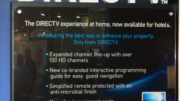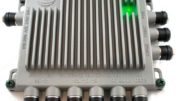Seems like magic, right? You take this little thing about the size of a basketball, put it on a flat surface, and a minute or so later you have satellite TV. When you think about how satellites are 22,000 miles away, this seems like a bit of science fiction come true. But how does it really work?
Back in 2013, the team and I took apart DISH’s Tailgater, which was a portable dish made by KING, to see just how the thing worked. That video’s been around the block a few times and all I can say is hopefully I’ve gotten a little better at making videos since then…
It’s still pretty accurate
If you watch the video and ignore the goofy narrator, you’ll get a pretty good idea of how a portable satellite dish works. It’s a combination of clever design and old-fashioned engineering.
Step 1: “Home” the dish
Connecting the portable dish to a receiver will let it get power from the receiver. In most cases the receiver will provide between 19 and 21 volts over the coaxial cable. It’s important that the dish get at least 16 volts, preferably more, so that it can operate and also supply the signal back to the receiver in a way that the signal is expecting it.
The electronics all start booting up, and generally speaking, the dish will spin all the way around, then up and down, to make sure that it can move without anything going wrong. At the end of all the motion, the dish ends up in the middle of its track, pointing about halfway up the sky. In this home position, the dish is ready to do the hard work.
Step 2: Find the main satellite
The next step is for the dish to try to find a signal from the “main” satellite in the cluster. DIRECTV’s satellites are at the 99, 101, and 103 west longitude locations. DISH has two clusters. Its Western Arc is at 110, 119, and 129 west longitude. Its Eastern Arc is at 61 and 72, west longitude. (A third location, at 77 west, stopped broadcasting in 2021.) If necessary, the dish figures out if it should be looking for DIRECTV or DISH signals. Sometimes a dish can ONLY be used with one or the other. Sometimes there are switches or software settings that need to be changed.
Armed with the knowledge of what signal it should be looking for, the dish starts spinning. It’s looking for the most important satellite in the cluster. For DIRECTV, that’s the 101 satellite, since portable dishes can’t get the signals from the 99 and 103 locations. For DISH, that’s generally the 119 or 61.5 location.
The dish spins slowly until it gets even the slightest hint of a signal. Because it’s not aimed directly at the satellite, it’s not going to pick up a full signal yet. In the Tailgater, there was a lens that helped signals get to the LNB (the central receiving antenna of the dish) even if it was off axis.
As soon as the dish can confirm it’s found the right satellite, the next step can begin.
Step 3: Elevate me (here? in front of all these people?)
Now, the dish is getting some sort of signal, even if it’s a weak on. Adjusting the dish’s elevation, in other words, its angle from the ground, helps lock in the signal.
The dish locks in its “azimuth” motor (the one that spins around) and unlocks its “elevation” motor. It starts moving up, then down, checking the signal to make sure it’s going in the right direction. After it finds the strongest possible signal, it locks everything down. The dish is aimed, and you start watching TV.
What if you want a channel on a different satellite?
DIRECTV operates a small number of standard definition channels at the 119 west location. With DISH, there are channels on several different satellites. When the portable dish is tuned to its main satellite, it will have some idea where to go if you ask for a channel on a different satellite. The aiming process goes faster, and you’ll generally only have to wait less than a minute to tune into that new satellite.
What if something “happens” to the dish?
As in, someone coming up to the dish and saying “Dat’s a nice dish ya has dere. Be a shame if something was ta…. happen ta it?” I suppose that’s a possibility if you find yourself in a gangster movie. More likely, someone trips over it or kicks it accidentally, or that sort of thing. Not to fear. If the dish itself realizes that signal is lost, it will try to reaim itself. Depending on the degree to which something has “happened,” this could end up taking as long as the initial aim. Usually it doesn’t.
Get portable dishes and a whole lot more from Solid Signal
You’ll find portable, self-aiming dishes plus a whole lot more when you shop the great selection at Solid Signal. We’ll give you more than that, though. You’ll find helpful people who really want to make sure you get what you need. We call it “white-glove” service. Other web sites don’t even publish their phone numbers. We actually pick up the phone during East Coast business hours. Why East Coast business hours? Because we don’t use overseas call centers. We have a full tech center in Novi, Michigan, in the good old U. S. of A. When you call, you’ll get a real professional, not a script reader. Don’t believe me? Try it out! Call us at 888-233-7563. If it’s after business hours, fill out the form below. We’ll get back to you, usually within one business day.





